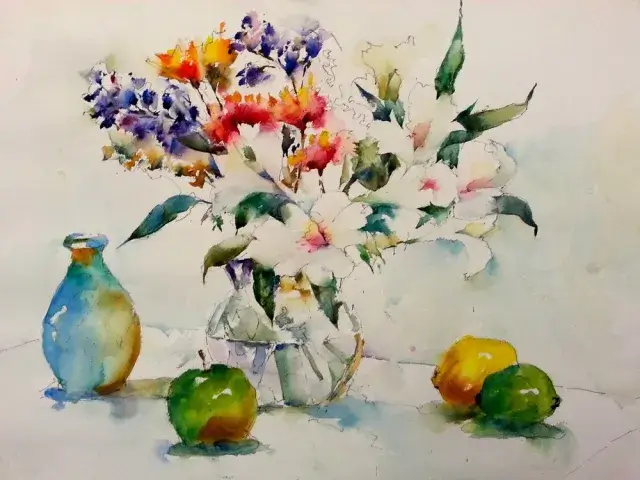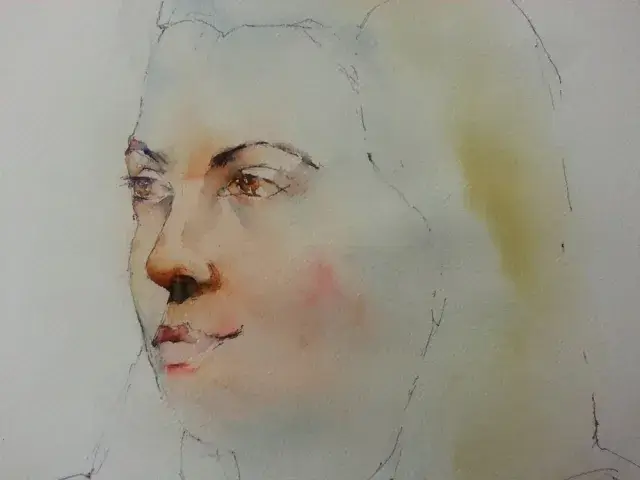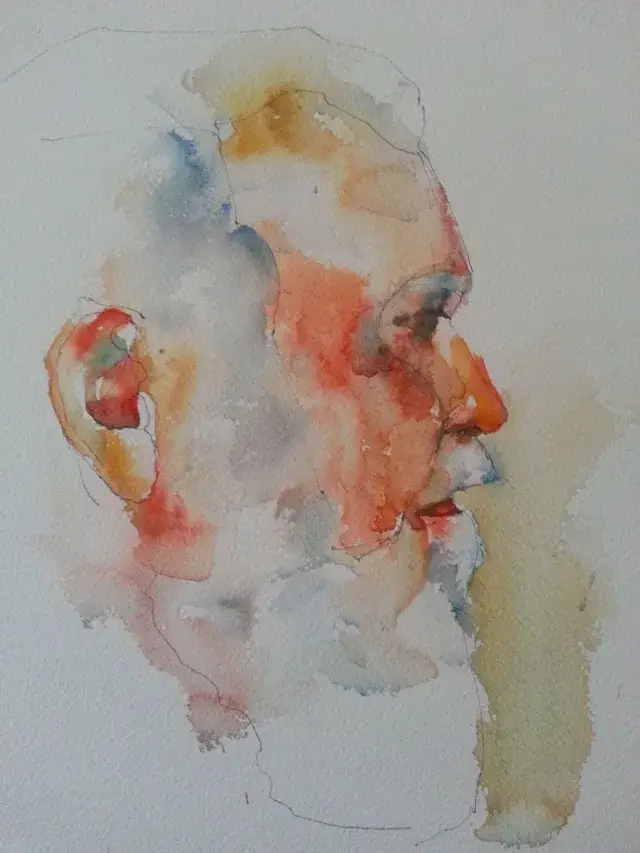Results of day 3 – I’m pretty chuffed with this. No Charlie the seagull though.
Full story :
Day 3 – still life day. And there was his seagullness himself. And doesn’t he look fine?
So today was flowers, fruit and stuff. I’ve been looking forward to this one especially (and not just for the seagulls). Flowers are not my favorite things to paint, mainly because I’m crap at them so I was all eyes and ears to see how Mr Reid went about things.
btw – this was my view from the back row. This would be pretty useless apart from the fact I’d bought some small binoculars with me. They are fantastic! It’s like being 6 inches from the paper. You can keep your front row seats.
Anyway – on with the demo. First the drawing as usual. He was using a different paper today – Schut paper. This is dutch and not widely available in the US. It’s not cheap – about twice the prices of Arches – and it has the distinction of being Judy Reid’s favorite paper. Apparently it is very absorbent so doesn’t allow much lifting or reworking which isn’t a problem with Mr R’s technique. It also has an interesting texture. It’s supposedly rough but it didn’t look like the usual rough texture which has a pronounced tooth to it. The tooth was less pronounced and coarser grained which allows for interesting brushwork without feeling like you’re painting on a brick (something which Mr R. said about Arches 300lb rough. Chortle!)
There wasn’t as much description going on today as there was with the figure painting and Mr R pretty much just got on with it. First there was 30 minutes of contour drawing. Emphasis on drawing connected objects, joining shadows to objects and giving as much, or more, emphasis to the inside shapes of things.
The setup – with seagull. Mr Reid is a big fan of a non-arranged arrangement and likes to paint things that look as though they’ve just been left there. He also likes things that just happen to be at hand – hence the paint brushes and tubes and the Edward Hopper book.
An action photo. He sits very close to the subject and very low down. This gives his figure paintings a distinctive look – the model is above eye-level with a good view of the nostrils and a relatively small head due to the perspective. For the still lives this effect is less pronounced.
Towards the end of the first 30 minutes of painting. Everything is pretty much painted just once and left. He leaves a lot of white space which certainly isn’t evident in the photo but gives a liveliness to the painting. He’s also extremely careful about where he places his darks. For white flowers the dark leaves a pretty much all that defines their boundaries. Similarly he treats his edges with great care – which ones to keep sharp and which ones to keep soft to just give an impression.
You can just about see the effect of the Schut paper here. In the lighter areas you can see the coarse soft tooth – it gives a mottled finish to the paint. you can also see the amount of white space he’s left in the foliage.
Here we are almost finished. He got rather grumpy at this point. The art center is having some renovations done in the basement and they were putting up drywall. This apparently involves the use of a tool that sounds like chairs scraping across floorboards every 5 seconds and gets really annoying. About 5 minutes after this Mr R. got up and refused to do any more. Don’t blame him really – it was very annoying.
The finished painting (completed after the drywallers had gone to lunch). And very nice it is too.
Critique Time
Each of us had a critique of one of our paintings over lunch. He was very kind to everyone but not to the point of abject flattery. If your painting has a person with a head that’s five times the size of their feet he will point this out as probably not the best feature of the painting. But we don’t really need to be told that.
Now it’s our turn
So – on to the still life. There were 6 different ones set up around the room. I wanted Charlie the seagull but the front row people had the first choice so I didn’t get the chance. I did want an arrangement with a lot of white flowers however so I plumped for the one below. I was sharing this with other people and they decided they wanted to clump all the fruit together. I really didn’t want this – I wanted the scattered approach with different objects linked by shadows. I snuck in the lemon and lime on the right hand side and chose to ignore the squash things.
The drawing – I’m usually pretty happy at this stage. This took around 30 minutes to do.
The start of the painting – probably after around 45 minutes. This was an extremely difficult painting to do and I concentrated extremely hard. I usually finish a painting in well under two hours but this was close on a 3 hour job and I hadn’t really finished then.
Having said that I really learned a lot in this afternoon’s session. It felt like putting a puzzle together. Where do I place the leaves to make sure the flowers stand out? Where should I have sharp edges to the flowers and where should I leave things soft? Where do I put broad strokes and where to put detailed ones?

The finished piece. (There are a couple of gaps but I ran out of time). This is a huge improvement over my previous flower pictures.
Oh – Charles patted me on the shoulder and said ‘beautiful painting’. <Blush>
Finally some action shots of all of us at work. I think everyone had a pretty successful afternoon.
Right – I’m off for a well deserved Ruby Murray courtesy of Falmouth’s finest Indian establishment.






































